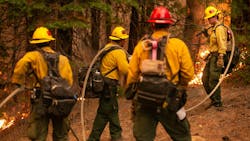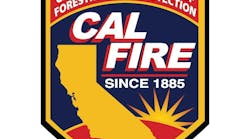Mar. 19—Last year, as California's fire season exploded with such monsters as the Caldor and Dixie fires, 60 wildland fire engines across the state sat idle. Others ran only part time.
There simply weren't enough firefighters to staff them.
The shortage of engine crews, documented in interviews with employees and records obtained by The Chronicle, is part of a broader, and potentially dangerous, decline in the number of federal firefighters stationed in California. From 2019 to 2021, the U.S. Forest Service, which is the federal government's primary wildland fire agency, saw its firefighter ranks drop by more than 20% in the state — a loss of more than 1,000 employees — records show.
The thinning workforce comes as larger and more frequent wildfires have pounded California, and it's casting a cloud over the upcoming fire season. A third year of drought looms, and firefighters are expecting another busy summer and fall.
Officials with the Forest Service say they're working quickly to fill gaps in employment. But there's only so much they can do with recruitment challenges beyond their control, including the state's high cost of living, the coronavirus pandemic and firefighter burnout. As long as these problems persist, coupled with the agency's historically low wages, officials acknowledge firefighting capacity is reduced.
"From an initial attack standpoint, could that (lack of personnel) have been the difference between catching a fire and preventing it from becoming a big one? Maybe, it certainly didn't help," said Brian Rhodes, a senior administrator for the Forest Service, who until this month worked as a deputy director in California, where he inherited a diminished roster when he started the job 2 1/2 years ago.
The agency has been tapping federal firefighters from across the country to help battle blazes in the state. It's also doing more contracting with local fire departments and private firefighters.
The extra help, however, only goes so far. Those who are not trained by the Forest Service in California don't necessarily have the qualifications they need, and the outside staffing hasn't filled all the holes. The contractors are also generally more expensive.
"It's not the same," said Lani Brown, a union representative with the National Federation of Federal Employees who works as a fire captain at the Eldorado National Forest in the central Sierra Nevada. "Everybody puts in 100% and does everything possible to save houses and keep people safe, but as you start working with less, there's just not help to send."
At the Eldorado National Forest, only two of 10 wildland fire engines operated on a full-time, seven-day-a-week schedule before last summer's 222,000-acre Caldor Fire struck, according to employees at the forest. The other eight engines, seven of which ran five days a week and one that didn't run at all, were brought into full-time service for the blaze.
The Caldor Fire spiraled into one of the season's most catastrophic, wiping out the town of Grizzly Flats before racing over the Sierra crest and threatening South Lake Tahoe. Some say a fully staffed Forest Service could have done more to contain the disaster and that the agency can no longer be relied upon.
"People (here) need to recognize now that when a fire starts, during the first couple of days, you're on your own," said Jeff Brown, an Amador County supervisor whose district was in the path of the Caldor Fire and who has expressed concern about limited firefighter staffing.
------
The Forest Service counted 3,956 firefighters at peak season last year in the Pacific Southwest Region, which consists almost entirely of California — it also encompasses Hawaii. The staffing was nearly 700 fewer people than planned for and well short of the roughly 5,000 in place four years earlier, according to Forest Service officials and documents.
The job vacancies included positions on the seven-person engine crews, which operate 273 trucks across California when fully staffed, as well as on hand crews, hotshot teams, smoke jumper units and more.
The Forest Service shares the task of fire suppression in California with the state Department of Forestry and Fire Prevention, or Cal Fire. Cal Fire's workforce, which is expected to swell to 8,000 employees at peak season this year, has remained mostly stable.
One of the biggest reasons that the Forest Service has struggled to retain and hire people, agency administrators and employees say, is the pay. An entry-level firefighter last year made as little as $13.45 an hour, less than California's minimum wage, while the most veteran fire supervisory positions topped out around $50,000 to $60,000 annually.
The workload can make these wages harder to justify. Many of the jobs are grueling, involving clearing trees and brush with shovels and chain saws and spending long hours under smoky skies. During peak season, firefighters can be on the road for months, working 16-hour days for two straight weeks before getting time off.
"When In-N-Out (Burger) is starting at $18 an hour, and we're starting at $13 or $15, it makes it hard to hire," said Pete Dutchick, a longtime hotshot and smoke jumper in California who spoke as a member of Grassroots Wildland Firefighters, an organization pushing for better firefighter compensation. "You might not get the overtime at In-N-Out like we do, but you're home with your family every night and you're not breathing in particulate matter."
The low federal pay is made worse by California's high costs and, recently, the coronavirus.
"The pandemic has really amplified the gaps in the job market and what jobs people are willing and not willing to do," said Rhodes, the Forest Service administrator. "The work has gotten harder, too, as fires have become bigger and more difficult to put out while the fire season has gotten longer. You do this cycle over and over again, and you do it five or six times, it's not so great round five or six."
Last year was one of the busiest for firefighters. About 2.6 million acres burned in California, the second most of any fire season in modern times. It was exceeded only by the 4.3 million acres burned a year earlier.
Eight of the 10 largest fires in state history have been in the past five years.
Many firefighters have left the Forest Service for different work or taken higher-paying firefighting jobs with state and local fire departments or Pacific Gas and Electric Co. Cal Fire, by contrast, pays entry-level seasonal firefighters a little over $20 an hour.
Still, Rhodes defended the performance of the leaner Forest Service.
"What people don't often realize is that 96% to 97% of fires are quickly suppressed," he said. "There are literally thousands of fires each year that the public knows nothing about."
------
Over the fall and winter, the Forest Service has posted hundreds of jobs that it's hiring for in California: engine crew members, hotshots, fuel reduction personnel, dispatchers, aviation support and more.
Agency administrators have an ambitious goal of increasing staffing, by mid-May, to what it was in the state four years earlier: at least 5,000 firefighters, between permanent and temporary employees.
Many firefighters and outside experts say more would probably be better to contend with the increasingly severe fire seasons as well as boost fire prevention efforts, such as tree thinning and prescribed burning, which the agency has pledged to do.
"We are being as aggressive as possible to increase the capacity of our fire suppression and fuels workforce," said Jonathan Groveman, a spokesperson for the Pacific Southwest Region. But "challenges still remain with recruitment and retention as a result of pay compared to other fire organizations in the state, cost of living, availability of affordable housing, fatigue and other factors."
Working in favor of the Forest Service this year are pay raises for firefighters.
Late last summer, as the wildfires raged, President Biden followed through on a pledge to begin paying federal firefighters a minimum of $15 an hour. The president had called their previous wages "ridiculously low."
The federal infrastructure bill will probably push earnings up higher. With $600 million committed to firefighter salaries, legislators, including Sen. Dianne Feinstein, have called for a new federal classification of firefighters that would either double their pay or increase it $20,000 a year, whichever is less. Minimum annual salaries would then approach $50,000. There is no timeline for the change.
Additional proposals, including a congressional bill known as Tim's Act, named after a smoke jumper who died last year after parachuting into a fire in New Mexico, have suggested offering new retirement benefits, housing stipends and mental health services.
While there's broad agreement that better compensation will help firefighter recruitment, it won't solve everything. Some worry that, with so many employees already gone, the institutional knowledge vital to much of the work won't be replaced.
"The reality is that the less experience and less qualifications the firefighters have, the harder it is to protect the public and to protect our communities," said Dutchick, the veteran hotshot and smoke jumper.
Among those leaving the Forest Service are members of incident management teams, the traveling squads of highly trained personnel that coordinate responses to large fires.
The lack of these teams has meant several wildfires over the past six years have gone without this management, according to a report prepared last year by the intergovernmental National Wildfire Coordinating Group. The result has been fires run by people with less know-how, causing local officials to "face the consequences."
The biggest concern, at least for the time being, remains the coming fire season. With a third year of drought developing in California, forests and grasslands are ripe for burning, creating the potential for another devastating year — and a clear need for more people on the fire lines.
"Nobody's thinking that we're going to fill all the positions we have," said Brown, the union representative at the Eldorado National Forest. Firefighting resources "are just going to be minimal. We just don't have the staff."
Kurtis Alexander is a San Francisco Chronicle staff writer. Email: [email protected] Twitter: @kurtisalexander
___
(c)2022 the San Francisco Chronicle
Visit the San Francisco Chronicle at www.sfchronicle.com
Distributed by Tribune Content Agency, LLC.






